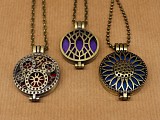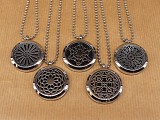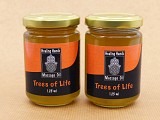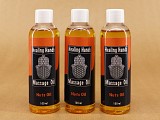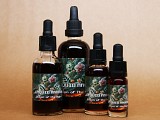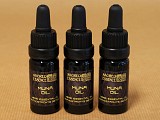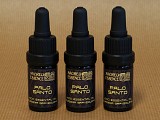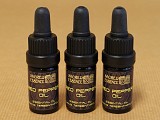Bottle With Pipette, 5 Ml from Brazil (SKU 4011)
Cacao absolute oil derived from the bean of the Theobroma cacao tree. It can be added to bath and body products for an intense chocolate aroma! To produce this absolute, a solvent is used. Although the absolute may contain therapeutic properties, it is not a true essential oil. This oil has been purified several times to make sure there is no oxydation process active, and that all impurities, water or oxygen are removed. This ensures a long shelf life and lasting aroma. Shake before use. Not suitable for consumption.
Packed in 5 ml Miron glass bottles with pipette.
This cacao absolute oil is derived from the cacao bean of the Theobroma cacao tree. It can be added to bath and body products if you want an intense chocolate aroma! There are actually two types of cacao (oils) used in bath and body products; the absolute and the essential oil. The pure absolute is extracted from the cacao beans. The essential oil is extracted by CO2, a newer method than that of traditional distillation.
In the case of absolutes, a solvent is used to extract the oil. Although the absolute may contain some therapeutic properties, it is not a true “essential oil.”
This oil has been purified several times to make sure there is no oxidation process active, and that all impurities, water or oxygen are removed. This ensures a long shelf life and lasting aroma.
Chocolate is made from the bean of the cacao tree Theobroma cacao. The seeds are dried and roasted and then processed to form Cocoa, the basic ingredient in Chocolate and Chocolate products. When boiled in milk, or milk and water, it is much used as an occasional substitute for Coffee (Coffea arabica), and for a drink at meals.
Chocolate is a psychoactive food. For some people, the lure of chocolate can be overwhelming. Cocoa contains certain chemicals and sensory properties that make the product very appealing. Cocoa contains theobromine (a chemical related to caffeine). The sugar in chocolate releases serotonin (a brain chemical related to a positive sense of well-being). The smooth, rich taste of chocolate provides sensory pleasure to the taste buds.
Chocolate is the most craved food among females. The motivation for chocolate preference seems to be primarily, if not entirely, sensory. Liking for Chocolate correlates significantly with liking for sweets and white Chocolate. The liking for the sensory properties could originate in innate or acquired liking based on the sweetness, texture and aroma of Chocolate, or it could be based in part on interactions between the postingestional effects of Chocolate and a person's state (e.g., mood, hormone levels). Based on correlational data, we find little evidence for a relation between addiction to Chocolate or the pharmacological (e.g., xanthine-based) effects of Chocolate and the liking for Chocolate.
The celebrated Italian libertine Giacomo Casanova (1725-1798) took Chocolate before bedding his conquests. This was on account of Chocolate's reputation as a subtle aphrodisiac.
Perhaps chocolate's key ingredient is its phenylethylamine "love-chemical". Yet the role of the "Chocolate amphetamine" is disputed. Most if not all Chocolate-derived phenylethylamine is metabolised before it reaches the central nervous system.
Some people may be sensitive to its effects in very small quantities. Like other palatable sweet foods, consumption of Chocolate causes the release of endorphins, the body's endogenous opiates. Enhanced endorphin-release reduces the Chocolate-eater's sensitivity to pain. Endorphins probably contribute to the warm inner glow induced in susceptible chocaholics.
Chocolate is one of Mexico's gifts to the world. It proved popular in Europe after the return of the Spaniards. So popular, in fact that ecclesiastical authorities frowned upon Chocolate drinking as immoral and provocative of immorality; finally a Papal Bull was issued prohibiting the faithful from drinking it on the grounds that it was an aphrodisiac.
Other names: Chocolate, Theobroma cacao.
Cacao was named Theobroma by Linnaeus, which literally translates as "Cocoa, food of the Gods". The Aztecs, Mayas and Toltecs believed that the cocoa tree was indeed a gift from the Gods. The word Cacao is derived from Olmec and the subsequent Mayan languages (Kakaw); the chocolate-related term Cacahuatl is Nahuatl (Aztec language), derived from Olmec/Mayan etymology, meaning "bitter water".
Cacao beans were used by the Aztecs to prepare to a hot, frothy beverage with stimulant and restorative properties. Chocolate itself was reserved for warriors, nobility and priests. The Aztecs esteemed its reputed ability to confer wisdom and vitality. Taken fermented as a drink, chocolate was also used in religious ceremonies. The sacred concoction was associated with Xochiquetzal, the goddess of fertility. Emperor Montezuma (1502-1520) allegedly drank 50 goblets a day. Aztec taxation was levied in Cacao beans. 100 Cacao beans could buy a slave. 12 Cacao beans bought the services of courtesan.
"The divine drink, which builds up resistance and fights fatigue. A cup of this precious drink cocoa permits a man to walk for a whole day without food." - Montezuma II. Legend has it that Montezuma II was the first to discover Chocolate ice and sent his runners to the heights of the volcano to bring back blocks of snow over which thick chocolate was poured, whipped, and served as chilled froth. When the ambassadors of Cortes encountered the Aztec Emperor, he was at the breakfast table shielded by a rich screen. Servants were filing by in endless procession with tempting delicacies. The most frequent (and most favoured) offering was a steaming aromatic drink named "Cacahuatl". This beverage was made from water and Cacao seeds - so valuable that they were used as currency in parts of Mexico and so costly that only royalty could afford them.
The finest chocolate confectionery, containing pure Chocolate liquor, with its remarkable nutritional constituents, is also the most nourishing; in the South African War and World Wars I and II, solid Chocolate was issued as standard rations for the troops and given by Queen Victoria as a Christmas gift to all her fighting men.
The first Chocolate factory in the United States opened in 1765 in the Massachusetts Bay Colony. In 1805, Conrad Van Houten, a Dutch chemist, invented a Cacao press that created confections of Cocoa butter and sugar. In 1876, Daniel Peter, a Swiss candymaker, developed milk Chocolate by adding condensed milk to Chocolate liquor, giving it a smoother texture through a process called conching (referring to the shape of the mixing vats).
Cacao (Theobroma cacao), or the Cocoa plant, belongs to the Sterculiaceae (Cacao family), is a small (4-8 meter tall) evergreen tree. Native to southern Mexico (Veracruz, Chiapas), Guatemala, Belize; now cultivated pantropically, especially in West Africa, Ceylon, Java.
Cocoa beans are found in the fruit, or pods, of the Cacao trees; each nine-inch pod contains 20 to 50 beans. The annual yield per tree is between 20 and 30 fruit pods. When seeds are ripe they rattle in the capsule when shaken; if separated from the capsule they soon become infertile, but if kept therein they retain their fertility for a long time.
Produced by organic growers in Peru, Cacao beans contain more antioxidants than red wine and 3 times more than green tea, Cacao beans embody a rich source of minerals. Harvested by hand as pods, the raw beans are selected for the finest quality and fermented to reduce their initial bitterness.
After cleaning the dried beans in natural water, they are peeled and their core extracted to be broken into “nibs”. These are ground into Cacao paste. The fat from the paste is extracted from the solid part and the residue dried and finely ground into Cacao powder. Cacao powder contains less fat and more fibre than the beans. The production process preserves a significant proportion of the nutritional value of the beans without any additives.
Cocoa beans contain about 2% theobromine, small amounts of caffeine, flavanoids, phenethylamine, vitamins (A, B1, B2, B3, C, E and pantothenic acid) and minarls (megnesium, calcium, iron, zinc, copper, potassium, manganese). Cocoa beans contain approximately 50% fat, primarily comprised of two saturated fatty acids, palmitic and stearic acids, and the mono unsaturated oleic acid.
Chocolate is also said to contain the chemical phenylethylamine, a natural amphetamine found in the human brain, which induces a feeling of euphoria. Phenylethylamine is an endogenous neuroamine which increases attention and activity. It is a naturally occurring trace amine in the brain. It releases mesolimbic dopamine in the pleasure-centres. It peaks during orgasm. Taken in unnaturally high doses, phenylethylamine can produce stereotyped behaviour more prominently even than amphetamine. Phenylethylamine has distinct binding sites but no specific neurons. It helps mediate feelings of attraction, excitement, giddiness, apprehension and euphoria.
Cacao, Erowid Herb Vault
The Chocolate Tree, Ethnobotanical Leaflets
This is a natural product, used as incense or in perfumery, or as an ingredient of incense and other perfumery or potpourri preparations.
Some incense plants or products may have some history of other folklore purposes, but we offer this product for its use as incense. Not food grade, not for consumption.
Please read our Terms & Conditions before placing your order.
